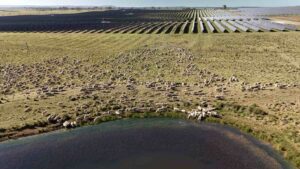The first large-scale solar and big battery storage installation in Australia – the Lakeland project near Cooktown in far north Queensland – has been officially connected to the grid.
The 10.8MW solar facility, combined with a 1.4MW/5.3MWh battery storage facility is located near the very edge of the grid and when first announced in 2016 was being pitched as a world-first for remote, edge of grid technology, and one that would trigger a host of similar projects across Australia.
The project had been due for completion nearly six months ago under its original timetable, but the complexity of the first-of-its-type project – for the developers, the local grid owner, and the market operator – pushed the timetable back.
It has been feeding into the grid since late November, but only recently completed its full sign off with Ergon, the local network operator, and the Australian Energy Market Operator.
The project was budgeted in 2016 at $42.5 million – which seems expensive now (and possibly explained by cost estimates at the time, the location, and its first-of-its kind status) – and received a $17.4 million grant from the Australian Renewable Energy Agency (ARENA).
It will be used to “firm up” the supply of solar power into the grid, and also to provide “islanding”, meaning that local homes and businesses can remain connected to the grid even in the case of a major fault elsewhere.
“Lakeland is a demonstration for how integrated solar and batteries can together deliver dispatchable supply feeding electricity into the grid when it is needed, whether or not the sun is available at that moment,” ARENA boss Ivor Frischknecht said in a statement.
“It will also be a test case for deliberate ‘islanding’, where a section of the grid continues to provide power while disconnected from the main grid. This capability will increase the reliability of local supply and pave the way for other fringe of the grid locations.”
Those “other” projects are already occurring. In Western Australia, Carnegie Clean Energy is to build a battery storage installation to perform much the same service for the town of Kalbarri, at the northern edge of the state’s main grid.
In South Australia, a battery is being built on behalf of Electranet and AGL to provide network security and islanding services on the Yorke Peninsula, where it will combine with the Wattle Point wind farm and local rooftop solar.
A bigger solar plus battery storage facility – 44MW of solar and 21MW/26MWh of battery storage – is also planned to go next to Tilt Renewables’ Snowtown wind farm in South Australia.
Meanwhile, the Kennedy energy park, also in Queensland, is building a wind-solar-and-battery storage facility, and numerous other solar and wind projects are looking to include battery storage, or in some cases pumped hydro.
Frischknecht said solar farms combined with storage were going to play a “hugely important role” in Australia’s electricity grid in the future.

Conergy managing director Christopher West said the connection of a project delivering reliable, renewable power to far north Queensland was a milestone for the company.“The region is abundant in solar resource, so it’s an ideal place to deliver solar projects like Lakeland.”
Conergy intends to add another 20MW of solar in stage 2 of the development, to be completed early next year, but will not commit to more storage until the first trials of the Knowledge Sharing Program, which includes ARENA, BHP, AEMO, Ergon and Origin, are completed.
These trials will look at the battery’s performance in islanding, providing FCAS, PV support mode, grid support mode, market mode and various combinations.
“Once completed, Lakeland and Lakeland II will provide 30MW of local solar generation, with storage,” West said in a statement.
“Imagine powering up approximately 4,015 average home air-conditioning units and running them all at the same time for eight hours through the heat of the day.
“That’s the combined production output capacity of Lakeland I and II. And better still, the energy is cleaner and more reliable for the people of Far North Queensland
West said that Having locally based energy generation in remote areas reduced power losses caused by lengthy transmission distances from power stations outside the region, and the impact on network performance from extreme heat in summer made local, dispatchable generation even more important.
Cook Shire Mayor Peter Scott said the project would improve supply reliability and was cleaner and sustainable.
“Cook Shire is very keen to continue our commitment to green alternative energy solutions and Lakeland I and now II are certainly an expression of that.”
Conergy ultimately aims to deliver one gigawatt of solar and storage for Australia, on the back of its global development of more than 3GW.
Federal environment and energy minister Josh Frydenberg said the battery meant energy generated during the day could be “captured and stored” for use when needed overnight and during peak usage times.
“For the people of Lakeland, who live on the fringe of the electricity grid where transmission is generally less reliable, this project helps ensure the lights stay on, even when the sun isn’t shining,” Frydenberg said.







